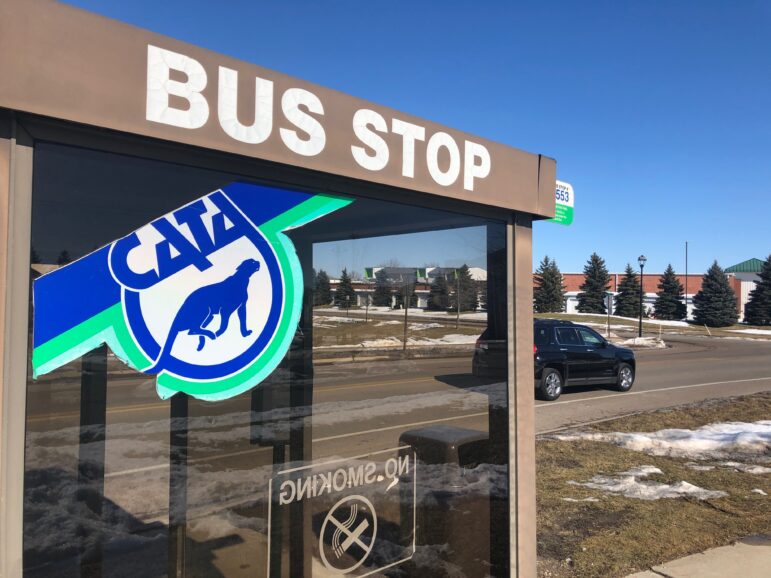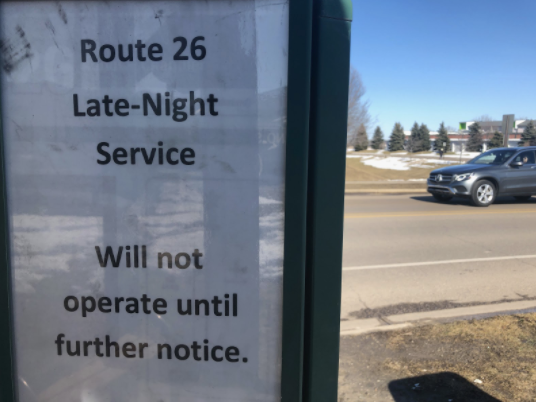Ingham County had its first reported cases of COVID-19 in March of 2020 and Capital Area Transportation Authority (CATA) reduced routes at Michigan State University from nine to four. The authority navigated reduced revenue and implemented several safety measures.

CATA’s financial status is sufficient
Despite decreased ridership, Lolo Robison, chief marketing and public information officer, said CATA’s finances are “very strong” and were “very solid heading into the pandemic.”
Voters in Lansing, East Lansing and several Ingham County townships passed a tax renewal on March 10, 2020, to provide CATA almost $19 million in annual funding, 36% of its $53 million budget.
“Our voters did pass CATA’s millage by a 72% of the total vote, and it was a very positive thing and then we immediately went into our pandemic response mode,” Robison said.
CATA was also aided by the Federal Transit Administration, which provided awards of $18.3 million and $16.2 million.
Robison said these grants offset costs associated with COVID-19 and allowed CATA to provide personal protective equipment to employees.
CATA also did not charge riders for a portion of time. Robison said CATA did not furlough nor terminate any employees and wages were not reduced.
Robison, who also oversees customer experience, said CATA added temporary employees to assist with customer experience during COVID-19.
“It was a huge value I think that we were able to allow for them to come on board and they did a phenomenal job and we ended up hiring three of them,” Robison said.
MSU decreased its contract due to very few residents living on campus in fall 2020 and spring 2021 according to Stephanie O’Donnell, MSU Police Department traffic engineer and CATA contract administrator.
CATA has taken several safety measures
To date, Robison said no cases of COVID-19 have been traced to CATA buses and CATA’s trips per day ranged from around 6,000 to 7,500 in weeks during February.
Robison said CATA has employed all health and safety practices in conjunction with the Ingham County Health Department.
“We had them come on our buses last year, and help us identify how we can safely operate an essential service for those who absolutely need to use CATA to get to where they need to go,” Robison said.
Robison said CATA staff sanitize and disinfect all surfaces on buses.
Several employees also transitioned to working remotely to limit staff inside the office.
“I think we got a really good protocol in place and have maintained it throughout the pandemic,” Robison said.
Isabella Agrusa, an MSU freshman studying international relations, travels on CATA several times a week.
Agrusa said she feels safe when traveling on CATA because it is easy to socially distance and the safety protocols are sufficient. She said she is often accompanied by only one or two riders.
Some bus routes were altered, mostly at MSU
CATA’s reduced number of on campus routes include route 32, 34, 35, 36 and all operate seven days a week except 32.
Robison said all the same locations on campus are serviced as before COVID-19. However, wait times at stations increased from seven to 10 minutes to 30 minutes.
“There was no need to redesign the route,” Robison said. “They already existed and traveled all of the campus locations to provide necessary levels of service and to transport students and faculty and staff to the buildings that are open.”
O’Donnell said MSU and CATA maintained late-night service and there are the same number of on-campus routes operating this spring as there were in fall 2020.

“Though we knew that there were going to be more people on campus starting in the spring semester, we thought we would start with continuing the same level of service that we were providing in the fall, and then make changes if necessary,” O’Donnell said.
CATA maintained its off-campus to on-campus routes, which includes routes 20, 22, 23, 24, 25, 26, and service levels for route 26 were decreased. Monday through Friday wait times were increased from six to 10 minutes to 15 minutes. The only entirely off-campus route suspended is route 16, the Grab & Go Express from downtown Lansing to Old Town Lansing.
“I’m very proud of our workforce. I think we all are here doing what we should be doing, and at the same time keeping all of our riders and our employees and the public as safe as we possibly can,” Robison remarked.
O’Donnell said MSU’s 2021 fall contract with CATA will be driven by the percentage of students living on campus and how many classes will be in-person in the fall.